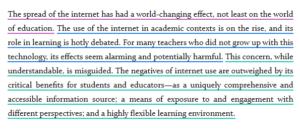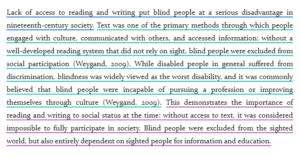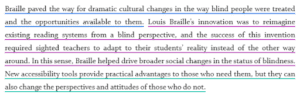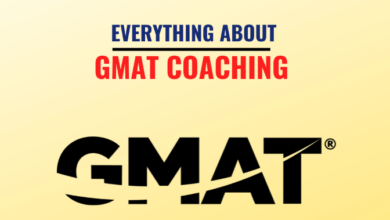How write an Essay | beginner guide with steps & example

You have been assigned an essay for the first time, and you want to make the right start and write it in a way that will get you an A-grade.
If that is what you want, congrats! You are at the right place, because this post will guide you on how to write an essay in a way that will get you an A-grade.
What is an essay?
An academic essay is a piece of content in which the writer presents his argument to his readers. A good academic essay must be;
- focused
- develop an argument
- Use evidence, analysis, and interpretation.
Though there are many types of essays, and each has its specific requirements, this post will act as a general guide to get your essay right – without going into the details of any specific type of essay.
The guide: Three stages of writing an essay
Now, let’s learn how to approach the task and how to write an effective essay – which you can be proud of, and your professor is happy to see. The best way to approach your essay is to break the task down into three stages.
Stage#1 – Prepare
Get ready for the project!
Understand the task and define your topic
You cannot write a good essay, if you do not have answers to these questions:
- What does your professor want from you?
- What is the length of the essay and how much time do you have?
Once you have the answers, you should move on to the topic of your essay. If you are given a choice to choose your won topic, you should always go for a topic;
- That you are interested in
- That you understand
And if you are assigned a topic from your professor, then you should ask for your professor’s help in understanding the topic and clearing any confusion.
Research and come up with a thesis
Go through the material on the topic and work out the position and perspective that you are going to take on the topic. The purpose of this research is to gather evidence to support your view points and defend your position on the topic.
You have to go through both primary and secondary sources to have an in-depth understanding of the topic – only then will you be able to have a strong position.
Once you are done researching, you have to take a position on the topic and come up with a thesis. A thesis is the central argument of your essay and it states your view on the topic that you have formed after research.
Create the outline
An outline is a map of the project. It helps you plan out the project in a way that highlights all the areas you are going to cover and in what order you are going to present your arguments.
An outline is like the initial stage of a rough draft, and is necessary to keep your on track and prevent you from getting lost – especially if your essay requires more than one sittings to complete.
Stage#2 – Write
As soon as you have created the outline, you can start writing.
Introduction
It makes up around 10-20% of your essay and the purpose is to set the tone for your essay and let the readers know what they should expect from your essay.
Hook your reader
What should be the very first sentence of your essay? There are a number of ways you can write the first sentence. A few ways to write the hook can be to start with a question to get your reader thinking, an interesting fact or a statement that emphasizes the importance of your topic.
Remember, the purpose of the first sentence is to accomplish these three things
- Pique your readers interest
- Get your reader curious
- Get him “hooked” so he reads the whole essay.
Provide background on your topic
Once done with the hook, you have to give a little context. The purpose is to help your reader understand your argument.
You can do that by providing background information on the topic or giving your readers an overview of research already being done on the topic.
Remember, you have to keep the introduction short.
Present the thesis statement
Once you have given your readers, little bit of background on the topic, you should come up with a thesis statement.
A thesis statement is the central argument of your essay and it clarifies your position on the topic.  Example of an essay introduction
Example of an essay introduction
In the above mentioned example, the first two lines underlined with purple are the “hook”, the next three lines underlined in blue are “background” and then comes the “thesis statement” that is underlined with green.
Body
Your essay’s body is the main portion – this is where you present your arguments in a convincing manner that supports your thesis.
Length of the body text
Body constitutes around 60-80% of your essay and is the largest portion of your essay.
Paragraph structure
Your essay body should be divided into paragraphs. And each of the paragraphs should have one idea that or point as its main focus.
The idea that the paragraph is going to focus on, is presented in the first line and the next few lines present the evidence in support of that idea. Once the evidence is presented, the author interprets the evidence in a way that supports the writer’s view-point – and the paragraph ends with interpretation.
 Example of an essay’s “body” paragraph
Example of an essay’s “body” paragraph
The blue underlined lines are an example of “topic sentence”, the green underlined sentences are the “evidence” and the purple underlined sentences represent the writers “interpretation” of the evidence and how it links to the topic.
Conclusion
After the body, comes the conclusion and it is the final paragraph of an essay. It should generally take up no more than 10–15% of the text. A strong essay conclusion:
- Refers back to the thesis
- Reviews the main points of your essay
- States the implications and convinces your readers why your argument matters.
A great conclusion should finish with a memorable or impactful sentence that leaves the reader with a strong final impression.

Example of an essay’s “conclusion”
In the above mentioned example, the text underlined blue refers back to the thesis statement, the sentences underlined with purple review the key points of the essay, and the very last sentences state the broader implications, and those are underlined with green.
Stage#3 – Revise
If you think your essay is ready for submission as soon as you have written the conclusion, you are wrong!
Proofread
Once done writing the essay, you must critically proofread the content of the essay to see if you have accomplished what you aimed to accomplish.
Proofreading your essay will make sure that it is free from any grammatical mistakes and the flow of the information is correct.
Check for plagiarism
If your essay has plagiarism that exceeds the limit set by your professor, then it is not going t be accepted – and all your effort will go down the drain hole.
Obviously you don’t want that. Hence, you should check the plagiarism before submitting your essay. There are both free and paid plagiarism checker tools – go for one that suites you best.
Some additional tips:
Now you are aware of the process that will help you write the perfect essay, but there are instances when you don’t have time or the energy to follow this lengthy process. What do you do then? Well, if you are lucky to have a friend who can offer you some Essay Help UK-style then ring him and get him to help you. But that happens rarely, how many of us have friends who are that helpful? Preparing for an essay also requires the latest news and current affairs. Reading daily newspaper or current affairs pdf may help you to get updated. This may give you additional updated points. Current affairs not only helps you to learn the latest news, it also helps you in many ways for a career like banking exams. Reading newspapers is a good habit. Start practicing today.
If you don’t have that friend then you must consider following these tips:
- Look for Write my essay UK– based online and outsource your essay to them.
- Review free essay samples to get the idea quickly.
- Make essay-writing a group activity – it will make the task fun.
- Read guides for the specific type of essay you are assigned.
Following these tips will help you steer clear of any troubles that an essay might present.
What did you learn?
The check list
- How to prepare for your essay
- How to write an essay’s introduction, body and conclusion.
- What to look for when revising your essay.
- And a few additional tips that can come in handy
Now, you are good to have a go at your essay…




